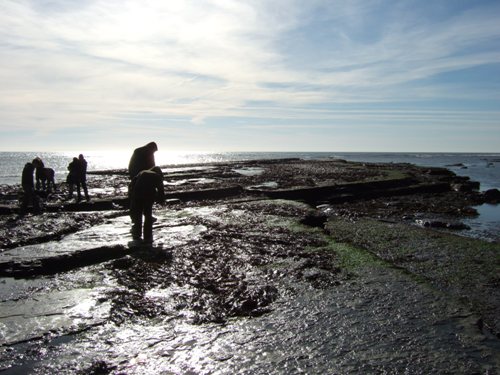Rock pooling

The Dorset coast is indisputably a great place to discover marine life, and this can be done easily by exploring the many rock pools that become accessible when the tide goes out. Looking in rock pools can be really fun as they are natural aquariums where you can discover anemones, crabs, limpets, winkles and an array of seaweeds.
Take notice of warning signs along the coast. Stay well away from cliffs and mudflows at all times and beware of quicksand.
In an emergency:
- Always be aware of what the tide is doing – don’t get caught out on an incoming tide
What do I need?
You don’t really need anything but rock pooling can be more enjoyable if you have:
When is the best time to do it?
Rockpooling can be done all year round on the Dorset coast but you should always check the weather and tide times before you go out.
Rock Pools
The closer the rock pool is to the shore, the less time it gets covered by the sea when the tide comes in. Conversely, the rock pools closer to the sea spend more time underwater. Rock pools are subject to exposure conditions such as: weather, light, temperature and salinity.
Each rock pool varies in depth, structure and the different types of creatures and seaweeds. Some of the creatures you are likely to discover are shrimp, crabs, starfish, molluscs and anemones.
Planning your trip
When to go
Planning to go rock pooling is best but not always essential. However some places in Dorset depend on going at low tide when the rock pools become exposed. Start with the low tide rock pools and then work your way up if the tide is on the way back in, alternatively explore the pools closer to the shore when the tide is in and work your way outward.Do your bit:
Watch out for the environment
- Take all rubbish home - do not discard rubbish on the beach. Find out more about Marine litter in Dorset.
- Always put any creatures back where you found them.
- Any rocks that you move or turn over should be returned to their original position as many creatures hide under rocks to protect themselves from waves and predators.
- Creatures that attach themselves to rocks such as limpets and seaweed need to stay attached to survive so please don’t remove them.
- Check the tide (using the iCoast website) and be aware of the position of the rock pooling areas in relation to the incoming tide. You don’t want to be cut off from the land.
- Report live strandings of cetaceans, and injured/entangled marine mammals to British Divers Marine Life Rescue (BDMLR) on 01825 765546 (24 hours). Report all other live injured or entangled animals to RSPCA 08705 555999
Staying safe
- Be sun smart - wear suitable sun protection when the sun is shining
- If you decide to explore rock pools alone tell someone where you are going and when you’ll be back.
- Always be aware of the tide – don’t get caught out
- Handle any creatures carefully as some have defence mechanisms and if you choose to pick them up don’t be surprised at their attempts to sting, bite or pinch you.
-
- Call 999 and ask for the Coastguard
- Suitable sturdy footwear as the areas around rock pools are often slippery and wet.
- A net to gently pick up and observe what you found.
- A bucket for emptying the contents of your net for a better chance to view any sea creatures, but don’t forget to put them back.
- Patience – often its best to sit and wait to get the best discoveries.
- A seashore guide to help you identify what you have found.
- Disposable cleansing wipes - after handling rock pool creatures you are encouraged to clean your hands afterwards, especially before eating.
- Shallow rock pools close to the shore aren’t likely to contain a wide variety of sea life. They are the most exposed and home to some creatures that can spend a long period of time out of water. You are likely to see green algae, sea slugs, periwinkles and dog whelks.
- Middle shore rock pools are located midway from the sea to the shore. They are more protected and can support a wider range of species. They are home to lots of different types of seaweed, anemones, goose barnacles sand goby fish shore and hermit crabs.
- Low tide rock pools are located further down the shore and spend much more time being covered by the sea.You are likely to find marine life that can’t be spotted along the rest of the shore, and in greater quantity and size. Look out for lobsters, crabs, sponges, sea slugs and eels.




